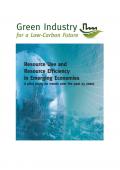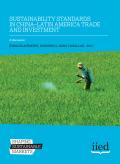
This report examines patterns and trends in resource use and resource efficiency in 16 selected emerging economies between 1985 and 2005. In order to facilitate comparison, the authors divided these countries into three different groups according to their dominant strategy of economic development since 1985: resource-based economies with a high ratio of raw materials in exports, including Algeria, Argentina, Brazil, Chile, Morocco, Russia and South Africa; industry-based economies which have been expanding their capacity to produce manufactured goods and related services, including China, Costa Rica, Malaysia, Mexico and the Republic of Korea; and services-based economies that have largely based their development since 1985 on services (e.g. tourism, financial or knowledge-based industries), including Barbados, Egypt, India and the Seychelles. While none of these three development paths is exclusive, they are useful categories for analytical purposes, as each is linked to specific physical or material profiles in terms of resource use and resource productivity.
The document presents a series of climate change-related projects that the International Finance Cooperation (IFC) has supported from all around the world. It also contains a series of tools for green investors, including:
China’s economic rise has transformed the global economy in a number of manufacturing industries. This paper investigates whether China’s transformative influence extends to the new green economy. Drawing on the debate about how China is driving major economic changes in the world – the ‘Asian drivers’ debate – it identifies five corridors of influence and investigates their relevance for the wind energy industries. Starting with the demand side, it suggests that the size and rapid growth of the Chinese market have a major influence on competitive parameters in the global wind power industry. While Western firms have found ways of participating in the growth of the Chinese market, the government's procurement regimes benefit Chinese firms. The latter have made big investments and learned fast, accumulating production capabilities that have led to changes in the global pecking order of lead firms. While the combined impact of Chinese market and production power is already visible, other influences are beginning to be felt – arising from China’s coordination, innovation and financing power.
The future of renewable energy is fundamentally a choice, not a foregone conclusion given technology and economic trends, according to this report. It examines the future of renewable energy in the context of: total energy share by sector; integration between utilities, buildings, industry and transportation; business models and investment; urban planning; national and regional policy; and technology, cost and market growth. The report is based on the opinions of 170 leading experts and the projections of 50 recently published scenarios. It finds a wide range of expert projections of the share of renewable energy in the global energy mix by 2050, with low estimates below 20 per cent to high estimates upwards of 50-95 per cent. Experts predicted that the expansion of renewable will accelerate through 2020, particularly in leading developing countries such as Argentina, Chile, Colombia, Egypt, Ghana, Indonesia, Jordan, Kenya, Mexico, Nigeria, the Philippines, South Africa and Thailand.
This report includes case studies on market growth and policy support for the European Union, the United States, Japan, China and India.

